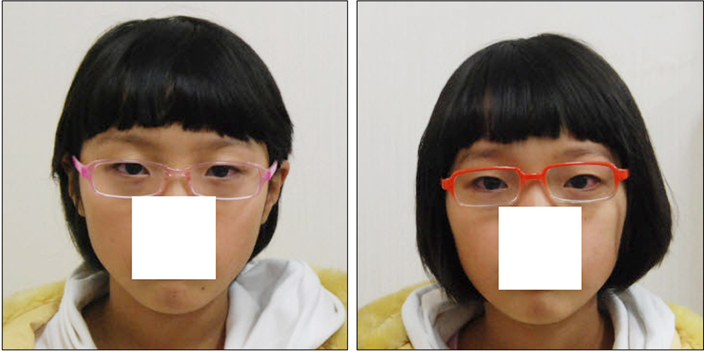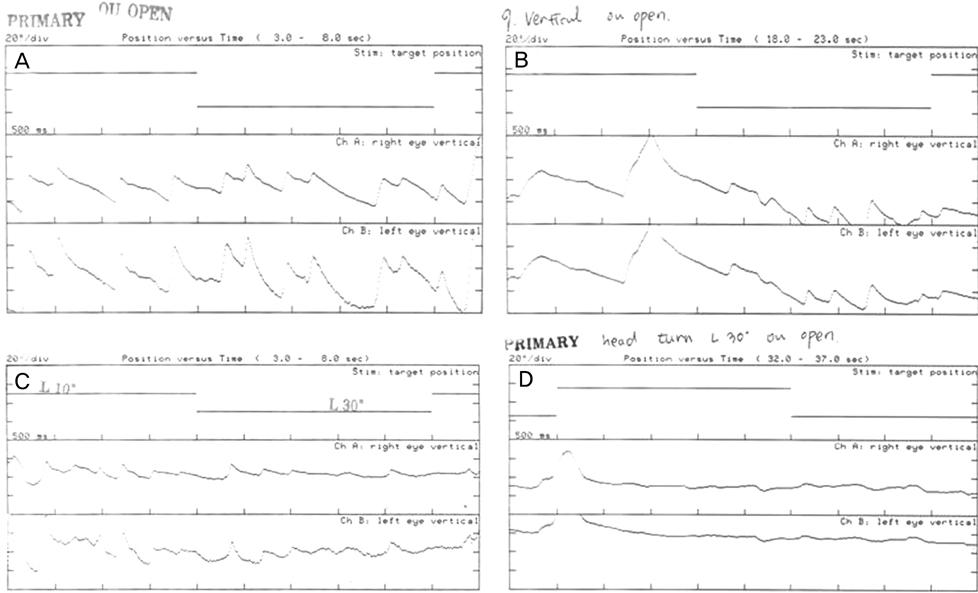Korean J Ophthalmol.
2010 Oct;24(5):314-317. 10.3341/kjo.2010.24.5.314.
Two Cases of Mirror-Image Eye Anomalies in Monozygotic Twins
- Affiliations
-
- 1The Institute of Vision Research, Department of Ophthalmology, Yonsei University College of Medicine, Seoul, Korea. 491209@yuhs.ac
- 2Department of Ophthalmology, Kwandong University College of Medicine, Goyang, Korea.
- KMID: 974328
- DOI: http://doi.org/10.3341/kjo.2010.24.5.314
Abstract
- We report two cases of mirror image anomalies in two different pairs of monozygotic twins. In case 1, the twins exhibited mirroring of strabismus and refractive errors. Twin 1 had 35 prism diopters (PD) right intermittent exotropia at distant fixation and myopic anisometropia that was spherical 2.00 diopters more myopic in the right eye. Twin 2 had 35 PD left intermittent exotropia at distant fixation and her left eye was more myopic by - spherical 1.00 diopters. In case 2, the twins were diagnosed with infantile nystagmus with upbeat jerk. Twin 1 exhibited a habitual head turn of 30degrees to the left with dampening of her nystagmus in dextroversion. Twin 2 also exhibited abnormal head position, but in his case the habitual turn was 30degrees to the right. We believe that this is the first report describing mirror imaged intermittent exotropia with anisometropia and infantile nystagmus with opposite abnormal head positions in pairs of monozygotic twins.
Keyword
MeSH Terms
Figure
Reference
-
1. Dirani M, Chamberlain M, Garoufalis P, et al. Mirror-image congenital esotropia in monozygotic twins. J Pediatr Ophthalmol Strabismus. 2006. 43:170–171.2. Aknin C, Allart JF, Rouland JF. Unilateral keratoconus and mirror image in a pair of monozygotic twins. J Fr Ophtalmol. 2007. 30:899–902.3. Gedda L, Brenci G, Franceschetti A, et al. Study of mirror imaging in twins. Prog Clin Biol Res. 1981. 69A:167–168.4. Doslak MJ, Dell'Osso LF, Daroff RB. Alexander's law: a model and resulting study. Ann Otol Rhinol Laryngol. 1982. 91(3 Pt 1):316–322.5. Park SJ, Kim JY, Baek SH, et al. One sister and brother with mirror image myopic anisometropia. Korean J Ophthalmol. 2010. 24:62–64.
- Full Text Links
- Actions
-
Cited
- CITED
-
- Close
- Share
- Similar articles
-
- Legg - Calve Perthes disease in Monozygotic Male Twins
- Ocular Myasthenia Gravis in Monozygotic Twins with Mirror-image Myopic Anisometropia
- Expression of Strabismus in Monozygotic Twins
- A case of congenital anomalies in both twins ( Anencephaly-Down syndrome )
- A Case of Urticaria Pigmentosa in Monozygotic Twins




